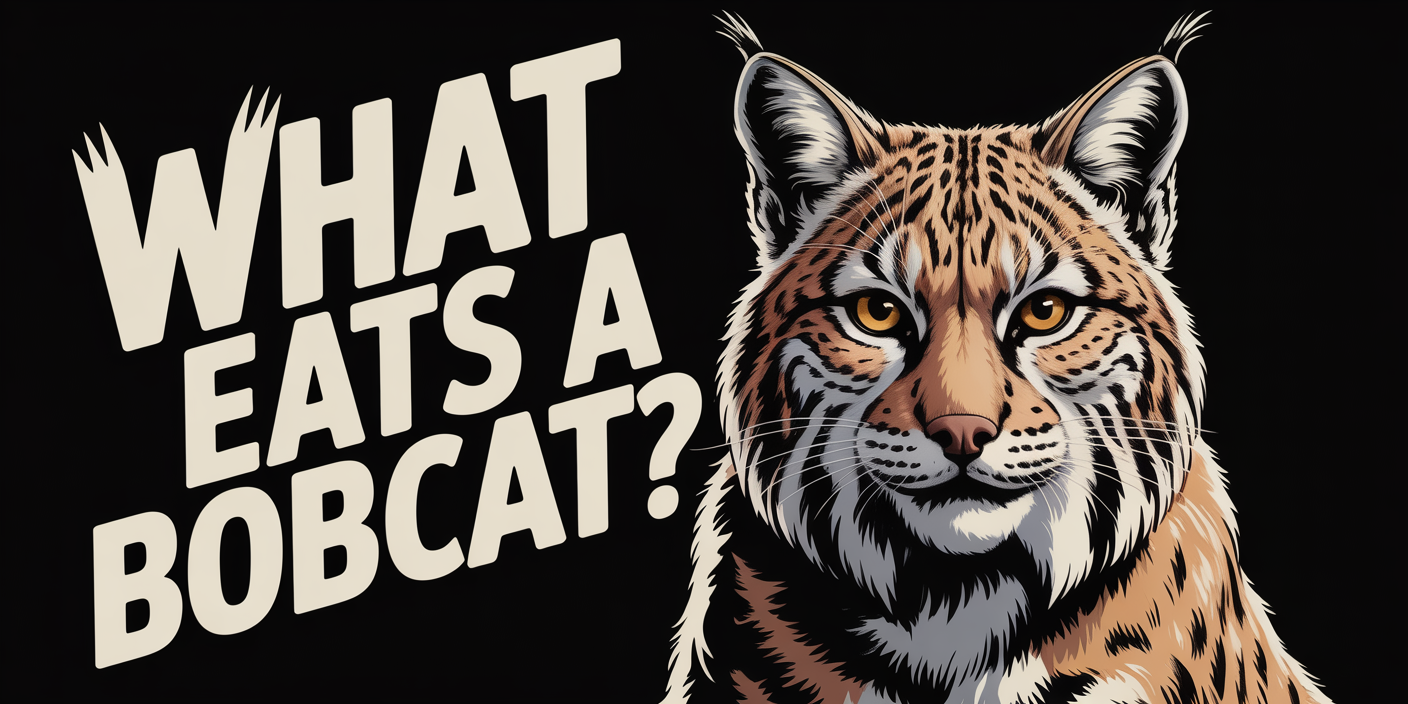Mountain lions, wolves, and sometimes large coyotes are among the few animals that may prey on adult bobcats, usually only in rare or desperate situations. Bobcat kittens face greater risks from eagles, owls, snakes, and alligators in some regions. Human-related dangers, like vehicle collisions and habitat loss, are actually the leading threat to bobcat survival.
Most people picture bobcats as untouchable predators, masters of their territory with nothing to fear. The truth is, even these stealthy hunters aren’t always at the top of the food chain. In rare cases, there are animals bold enough to see a bobcat as a meal, and the real threats might surprise you.
Understanding what eats a bobcat isn’t just wildlife trivia, it’s a peek into how nature keeps things balanced right in your own backyard. If you’re dealing with nuisance animals or want to keep your property safe, knowing how bobcats fit into the food web can help you make smarter decisions. That’s where AAAC Wildlife Removal comes in, offering expert help to manage wild neighbors; no matter where they land on the food chain.
Do Bobcats Have Natural Predators?
At first glance, bobcats seem to rule their territory without worry, thanks to their sharp senses and top-tier hunting skills. In reality, though, even these expert stalkers aren’t completely immune from danger. Adult bobcats rarely face predators in the wild, but that doesn’t mean they’re untouchable.
Many people assume that bobcats have an entire roster of enemies waiting to pounce, yet the truth is far less dramatic. Their main defense is their elusive nature, sticking to thick brush, hunting at odd hours, and rarely staying in one spot for long. Natural predators are few and far between, and most wild threats only target bobcat kittens, not fully grown adults.
Knowing the difference between myth and reality helps homeowners avoid overreacting or misjudging the wildlife on their property. If you’re noticing signs of a bobcat nearby, it’s a good idea to understand their actual risks, and how that might affect the animals and pets around your home.
Top Animals That Actually Eat Bobcats (Why It Hardly Ever Happens)
For all their swagger, bobcats don’t spend their lives looking over their shoulders, almost nothing hunts them on purpose. Even so, there are a few wild creatures capable of turning a bobcat into prey, most of them under exceptional circumstances. Here’s the real lineup of animals that actually eat bobcats, and why these run-ins are so uncommon.
Mountain Lions: Bobcat’s Biggest Fear
Mountain lions are the true apex predators in many of the same forests and mountain ranges where bobcats live. A mountain lion’s size and strength give it a massive advantage, and when territories overlap, a hungry or territorial mountain lion won’t hesitate to take down a bobcat. Most of these encounters end with the bobcat as dinner; nature isn’t sentimental.
Wolves and Coyotes: Only When Desperate
Wolves are powerful pack hunters, and a group can overpower nearly any animal in their range. On rare occasions, wolves will kill and eat bobcats if food is scarce or the bobcat stumbles into a den of hungry pups. Coyotes, though smaller, might gang up on a bobcat, but this is more about eliminating competition than filling their bellies. It takes serious hunger or a lucky ambush for canines to take down an adult bobcat.
Bears: Scavenger, Not Stalker
Bears typically ignore healthy bobcats, focusing instead on easier meals. However, if a bear comes across a dead or dying bobcat, maybe after a harsh winter or a fight, nothing goes to waste. In extremely rare cases, a bear may kill a bobcat over territory or food, but that’s not their normal menu.
Alligators: Swamp Ambush
In the southern United States, alligators can be a silent, deadly threat to bobcats that come too close to the water’s edge. These massive reptiles are ambush predators, and if a bobcat is distracted while drinking or hunting, an alligator might strike. Kittens and even adults aren’t safe if they’re caught off-guard, but these attacks are rare and usually opportunistic.
Large Snakes: Danger for the Young
In areas where giant constrictors like pythons or large rattlesnakes live, bobcat kittens may be at risk. These snakes can take down small mammals if given the chance. It’s highly unusual for an adult bobcat to fall victim, but an inexperienced kitten that strays too far from its den might wind up as prey for a hungry snake.
Birds of Prey: No Mercy for Kittens
Adult bobcats are too fierce and heavy for any bird of prey, but their kittens aren’t so lucky. Large eagles, great horned owls, and even hawks will snatch unguarded bobcat kittens if given the chance. These aerial hunters rely on surprise, and bobcat mothers have to be on constant alert to keep their young safe from above.
Other Bobcats: Nature’s Unfriendly Rivalry
It’s a harsh world out there, sometimes the biggest threat to a bobcat is another bobcat. Territorial battles can get brutal, especially during mating season. While cannibalism isn’t common, the loser of a serious fight may be killed and occasionally eaten, turning neighborly disputes into fatal encounters.
The Human Factor: Accidents and Loss of Habitat
Humans top the list when it comes to actual risk for bobcats, even if we’re not eating them. Most bobcat deaths happen thanks to vehicle collisions, illegal hunting, or getting caught in traps meant for other animals. Habitat destruction also puts bobcats in danger, pushing them into unfamiliar territory where the odds are stacked against them.
What Homeowners Should Know About Bobcat Predators and Managing Wildlife
Knowing which animals threaten bobcats isn’t just a fun fact, it’s a real advantage for anyone living near wild spaces. When you understand the risks bobcats face, you can predict their behavior, reduce the chance of unwanted encounters, and keep the entire ecosystem healthier.
A balanced property discourages both bobcats and their rivals from setting up shop near your home. When food sources like pet food, open garbage, and bird feeders are locked away, you not only keep bobcats at bay but also reduce the appeal for coyotes, raccoons, snakes, and even larger predators. Fencing off vulnerable areas, securing chicken coops, and clearing dense brush cuts down on hiding spots for all sorts of wildlife; not just bobcats.
Take these proactive steps to keep your property in check:
- Store pet food, trash, and compost securely indoors or in animal-proof bins.
- Install motion-activated lights or alarms to make your yard less attractive to prowlers.
- Maintain clear sight lines around your property by trimming shrubs and removing debris.
- Keep small pets indoors, especially at night, and supervise animals during dawn and dusk.
If you spot a bobcat or signs of wildlife you’re not comfortable managing, reach out to AAAC Wildlife Removal. Our team knows how to safely and legally handle bobcats, and we’re here to help homeowners avoid risky DIY attempts that could put people, pets, or wild animals in danger. With the right plan, you can keep your property balanced and safe for everyone; no matter where they fall on the food chain.
The Real Story Behind Bobcat Predators
Despite their reputation as fierce hunters, bobcats are not completely invincible. While only a few wild animals pose a real threat, it’s usually human activity that shapes their survival the most. By understanding the rare predators of bobcats and how these dynamics impact your own property, you’re already a step ahead in protecting your home and supporting local wildlife.
Remember, the smartest way to handle bobcat encounters, or any wildlife situation, is to keep your property secure and lean on professionals for help. AAAC Wildlife Removal is always ready with expert advice and safe, humane solutions to make your space less inviting to wild visitors. Keep your home balanced, your pets safe, and let the experts handle the wild side of the neighborhood.




